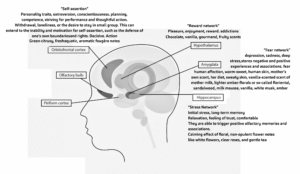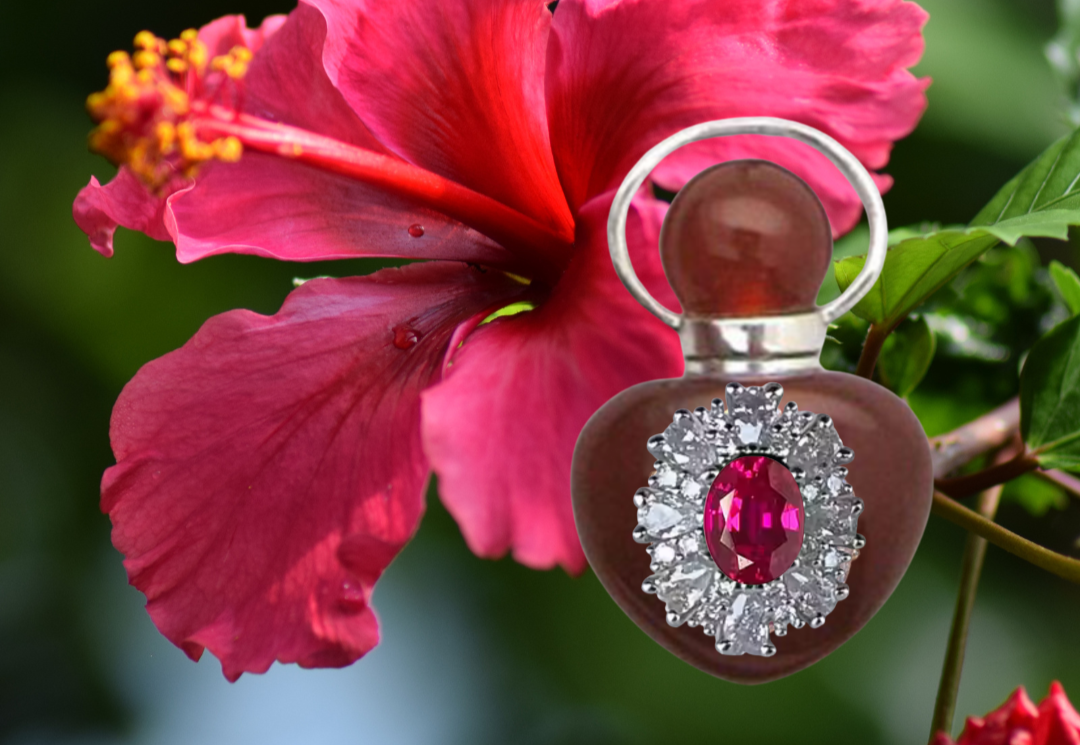Neuroperfumery: How Perfume Shapes Our Emotions and Perceptions
Neuroperfumery is the scientific study of how fragrances interact with the brain, particularly the regions that govern emotions, memory, and behavior. It explores the powerful connection between scent and our psychological responses.
Building on this understanding, our sense of smell, while often underestimated compared to sight or hearing, is surprisingly deep and strongly connected to how we experience the world around us. When we smell something at the same time as we see or hear, perfumes can become even more powerful, creating a fuller and more engaging experience for our senses. This isn’t just about remembering things; most people naturally link smells with other senses. For example, the fresh smell of citrus might make you think of bright colors. This natural way our senses blend together shows how much perfume can enrich how we perceive things overall, although personal experiences and cultural backgrounds can sometimes affect these sensory connections.
10 Facts About Neuroperfumery:
-
Scent has a direct, unfiltered pathway to the brain’s emotional and memory centers.
-
A brain region called the Orbitofrontal Cortex acts as a “chief perfume expert,” helping us consciously recognize and appreciate fragrance.
-
Bright, stimulating scents like citrus and pepper can engage the brain’s networks for self-assertion and confidence.
-
Our senses are interconnected; simply seeing a lemon can make you perceive its smell more intensely.
-
Warm, skin-like aromas like sandalwood and musk are known to soothe the amygdala, fostering feelings of trust and security.
-
The hippocampus links scent to our most powerful and distant memories, often from childhood.
-
Calming floral and soft woody scents can help to counteract the negative effects of stress on the brain.
-
The brain’s pleasure and reward system has a strong preference for sweet, gourmand notes like vanilla, chocolate, and ripe fruits.
-
A perfume can be intentionally designed as an elegant instrument to support and enhance your emotional well-being.
-
The most powerful fragrances create a multi-sensory experience, where a scent can evoke the feeling of a color, a texture, or even a piece of music.
HOW OUR BRAIN UNDERSTANDS SMELLS AND CONNECTS THEM TO OTHER SENSES
The science of our brain (neuropsychology) and the newer field of how scents affect the brain (neuroperfumery) are teaching us a lot about how we process smells and link them with what we see, hear, and feel. Using advanced tools that can see brain activity, like fMRI scans, scientists have mapped out in detail how our brain deals with smells. Interestingly, research shows that certain parts of our brain, even those connected to our personality, seem to have favorite scents. It’s like smells are “smart” – they seem to go directly to the brain areas where they can have the most impact.
One important area is the orbitofrontal cortex (OFC). This part of the brain helps us consciously recognize and understand smells and also creates those interesting connections between senses, like when a smell makes you think of a color. The OFC takes all the different smells in a perfume and combines them into one complete experience, which is key to truly appreciating a fragrance. You could think of the OFC as the brain’s “chief perfume expert.”
The OFC also acts like a central coordinator for all our senses, helping us blend them together. This is why we might connect a perfume with a specific color or type of music, or why some people even “see” scents as shapes or spaces. The OFC also allows us to make more complex judgments, like deciding if a perfume is worth the price or if it matches its bottle.
It’s also fascinating that the OFC, which is so involved in these sensory connections, seems to play a role in certain personality traits, especially being outgoing (extraversion). This part of the brain and the areas it connects with seem to really like the refreshing and slightly spicy smell of citrus. For people with this preference, these scents might naturally bring to mind bright colors, energetic shapes, and lively music.
THE ORBITOFRONTAL CORTEX: SELF-ASSERTION & BELONGING
Perfumes that start with lively scents, like ginger, pepper, and lime, often really appeal to that “chief perfume expert” part of our brain, the OFC. It seems the OFC enjoys smells that are stimulating and refreshing right away. Since the OFC is also linked to our sense of self-assurance and belonging, these fresh perfumes can be particularly helpful if you’re feeling down, isolated, or lacking confidence. They can boost your energy, make you feel more self-assured, and help you become more decisive – qualities often associated with feeling more extraverted and engaged. Similarly, perfumes with bright citrus notes like bergamot and orange, often mixed with aromatic herbs, also match what the OFC likes – lively and slightly sharp smells.
While the scents that appear later in these perfumes also affect other parts of the brain, it’s those initial, energizing smells that directly connect with the extraverted personality traits linked to the OFC. Sometimes, you can even see this connection in the packaging, which might use bright and fresh colors. Plus, these kinds of perfumes often activate another smell-processing area called the piriform cortex, making the experience even stronger for the OFC through a combination of different sensory signals.

From private study notes of Leïlïaani founder A-M. Leilaani
THE PIRIFORM CORTEX: THE BRAIN’S OLFACTORY NAVIGATOR
Working closely with the OFC is another brain area called the piriform cortex, which acts like a smart “scent manager.” This area is key in deciding how perfumes and individual smells affect our awareness, mood, and feelings. Because it’s strongly connected to our vision, it has some amazing abilities. It can make the impact of a perfume stronger and even tell our smell center (the olfactory bulb) what to notice and how to process it. This can make us more sensitive to certain smells or even help us filter out smells that don’t seem important.
The piriform cortex also organizes where scent information goes in the brain for further understanding. It talks a lot with the amygdala, which is like our emotional center, constantly sharing information about smells. This back-and-forth can even change the signals sent back to our smell center. Basically, the piriform cortex is a clever middleman, subtly guiding how we experience the world of scent. For example, it might prioritize sending a lively citrus smell to the OFC because it knows that area likes those kinds of scents. The piriform cortex can also influence our personality by triggering scent signals. Its connection to vision also explains why just seeing a lemon can make its smell seem stronger – it starts a chain reaction of our senses amplifying each other. Ideally, when all five senses work together like this, it creates a richer and deeper experience that’s processed in the OFC. Brain studies consistently show that when we see and smell something at the same time, our brain activity increases.
It’s interesting that even though we’re most aware of what we see, and smell might seem less important, our sense of smell plays a vital role in shaping our moods and emotions, often without us even realizing it. Many scents actually bypass our conscious awareness and go straight to the amygdala and its network, our emotional core. This direct processing leads to quick, often subconscious, feelings about whether a smell, and therefore a person or situation, feels good or bad.
THE AMYGDALA: TRUST AND SECURITY
The orbitofrontal cortex (OFC) is connected to three important brain circuits that help fine-tune smell signals and trigger different brain and emotional responses. The first one, called the amygdala loop, is especially important for understanding how scents affect our feelings. What’s interesting about this loop is that we can smell something and not even consciously realize it, yet that smell can strongly influence our emotions. Brain scans have shown that the amygdala really likes warm, skin-like smells, comforting woody scents, soft musky undertones, and creamy, milky aromas. When we smell these kinds of things, it can lead to deep emotional relaxation, making the amygdala, which is usually on alert, feel a sense of trust.
The amygdala, located deep in the part of our brain that deals with emotions, has long been known for processing negative feelings like anxiety and fear, as part of our “fight or flight” response. However, the amygdala loop also handles positive and relaxed states, contributing to feelings of trust, safety, and security.
This might explain the popularity of perfumes featuring prominent synthetic woody aroma chemicals, often described as cozy, ambery, and musky. Such compositions appear to deeply resonate with the amygdala, the brain region associated with emotions. Similarly, fragrances with warm amber-balsamic and subtly sweet characteristics can promote feelings of emotional well-being and security, directly appealing to this area of the brain. From a synesthetic and multisensory perspective, the packaging designs of some such perfumes, particularly those utilizing shades like violet and purple, may further enhance the olfactory experience. In color psychology, these hues are often linked to introspection and emotional depth, aligning with the amygdala’s area of influence.
THE PAPEZ CIRCUIT TAPESTRY OF MEMORY: PEACE AND BALANCE
The second control circuit involves the hippocampus, a part of the brain shaped like a seahorse that’s really important for forming memories, especially long-term memories and learning. The hippocampus gives us an amazing sense of smell memory, allowing us to remember scents from when we were very young and connect them to specific events and feelings.
Stress is really hard on the hippocampus. If we’re stressed for a long time, it can actually shrink because of too much of a stress hormone called cortisol. This can make it harder for us to accurately recognize and name flower smells. Studies have shown that this brain area can get much smaller under constant stress. So, it makes sense that the hippocampus prefers smells that help us relax and reduce stress. Aromatherapy has known for a long time that floral and soft woody scents, like rose and sandalwood, can be calming.
Perfumes that have a main scent built around a gentle “soft rose” smell seem to really connect with the hippocampus. While the initial fresh notes might affect other parts of the brain, the warm, woody base notes, like sandalwood, offer real relaxation for the hippocampus. When we’re stressed, our brain often appreciates calming pastel colors, while warm, earthy reddish-brown colors can create a feeling of harmony, peace, and balance. Also, soft purple colors, which are linked to thinking deeply and feeling protected (and are also connected to the amygdala), can have a positive psychological effect.
THE HYPOTHALAMUS NETWORK: PLEASURE AND REWARD
The third control circuit focuses on the brain’s reward system, which uses a chemical called dopamine. This system, along with a brain area called the hypothalamus, plays a big role in why we enjoy perfumes. The hypothalamus controls basic needs like hunger and thirst, but it also houses the areas for reward, pleasure, and addiction, which can make us feel joy and satisfaction.
The hypothalamus network is a central point for the dopamine system. Dopamine, often called the “happiness hormone,” is a chemical messenger in the brain. It’s key in driving our motivation and our desire for enjoyable experiences, including liking certain perfumes.
The hypothalamus and its network have specific smells they prefer. They really like chocolate, followed by vanilla and cinnamon, as well as fruity smells. A main thing they look for is sweetness and something that feels appealing, like the scent of ripe figs. This system generally likes sweet and food-like smells. In the world of perfume, the gourmandcategory, which reminds us of delicious desserts, fits perfectly with what the dopamine system enjoys.
In some perfumes, the hypothalamus immediately encounters the tempting smell of ripe fig right when you first smell it. Also, the fresh and fruity smells of bergamot and orange grab the attention of the orbitofrontal cortex, which likes citrus. Finally, the warm base scents like Cashmeran and pine resin, which can bring back pleasant memories, add to the overall joyful feeling of the perfume for the reward and pleasure system.
Even though a perfume might not be entirely food-like, those typical “sweet, edible, appealing” notes are often linked to red and magenta colors in how we think about colors. So, if you’re currently drawn to magenta, it might mean your brain is craving the fig note in certain perfumes, driven by a desire to feel happier. In the end, why we choose certain perfumes seems to be more connected to our cravings for sweetness than we might realize, especially if we’re trying to eat less sugar, even if we don’t consciously think we like sweet smells.
Introducing Leïlïaani Petalis®: Where Science Meets Sensory Well-being
COMING SOON!
Embark on a science-backed journey to elevate your well-being with Leïlïaani Petalis®. Our upcoming collection of mood-enhancing perfumes is meticulously crafted, drawing upon groundbreaking insights from neuroperfumery – the science dedicated to understanding how fragrances stimulate specific brain regions to foster feelings of calm, confidence, love, and joy. Contemporary research confirms the profound influence of scents on brain areas governing our emotions, stress response, and motivation. These are more than just fragrances; they are active perfumes, thoughtfully designed as tools to support your emotional self-care.
Leïlïaani Petalis® uniquely blends these modern scientific discoveries with the age-old wisdom of traditional flower therapies, including Bach Flower Remedies and Hawaiian Flower Essences. This harmonious fusion results in fragrances that not only enchant the senses with exquisite aromas but also work to transform your emotional landscape. This innovative approach to perfume therapy harnesses the potent synergy between the power of scent and the inherent healing properties of flowers.
Our wellness perfumes are grounded in the personal journey and expertise of Leïlïaani’s founder, Anne-Marie Leilaani. For the past three years, Anne-Marie has been immersed in the fascinating fields of Neuroscience, Neuroperfumery, and Neuropsychology. Driven by a profound personal passion, she is currently in the process of becoming a Certified Perfumotherapist. This pursuit stems from her lifelong connection with scent. Since childhood, Anne-Marie has intuitively used perfumes to cultivate an inner sanctuary, a sense of protective calm, and an aura of bliss, fueling a decades-long fascination with their powerful effects.
By uniting the precision of modern neuroperfumery, the gentle efficacy of flower therapy, and the artistry of fine perfumery, Leïlïaani® creates luxurious scents that serve as elegant instruments for achieving emotional harmony and holistic well-being. Elevate your daily routine and nurture your inner calm, confidence, and serenity with our upcoming wellness collection. Embrace the transformative power of scent, thoughtfully designed for your well-being.
IMPORTANT: Please kindly note that our perfumes are intended to support emotional well-being and should not be considered a substitute for professional medical advice or prescribed medication. Always consult with a healthcare provider for any health concerns.
Stay tuned for the launch of our first line of Leïlïaani Petalis® Wellness Perfumes.
Want to be the first to know?
[mc4wp_form id=721]
DISCOVER LEÏLÏAANI PARFUM JEWELS COLLECTION.



Add Comment